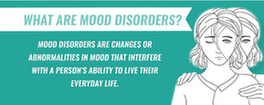Understanding the 10 Types of Mental Disorders
Understanding Mood Disorders
Exploring the Second of the 10 Types of Mental Disorders

A collection of mental health diseases known as mood disorders have a significant negative influence on a person’s emotional state and general well-being. Mood disorders, including their many forms, symptoms, probable causes, and accessible treatments, will be thoroughly discussed in this article. Understanding mood disorders better would help us develop empathy and better support others who are struggling with them.
What Are Mood Disorders?
Affective disorders, or mood disorders, are defined by serious disruptions in a person’s emotional state. T he individual’s capacity to function and enjoy life may be negatively impacted by these disruptions, which can vary from bouts of intense despair to bursts of high mood.
he individual’s capacity to function and enjoy life may be negatively impacted by these disruptions, which can vary from bouts of intense despair to bursts of high mood.
Advertisement
Types of Mood Disorders
There are several varieties of mood disorders, each with a unique set of characteristics and signs:
1. Depression
Major depressive disorder, generally known as depression, is characterized by chronic sorrow, despair, and a lack of interest in once-enjoyable activities. Depression may also be accompanied by physical symptoms such altered appetite, restless sleep, and exhaustion.
Extreme mood fluctuations are a hallmark of bipolar illness, formerly known as manic depression. People who have bipolar disorder go through moments of severe mania (elevated mood, high energy), which are followed by depressive spells.
Symptoms of Mood Disorders
Mood disorder symptoms might vary greatly, although they typically center on emotional states:
- Consistent feelings of sorrow, emptiness, and worthlessness are among the symptoms of depression. Physical symptoms might take the form of altered appetite, trouble sleeping, and low energy.
- Manic Symptoms: People who are going through a manic episode may feel more energized, chatty, impulsive, and confident than usual.
Causes and Risk Factors
The precise causes of mood disorders are complicated and frequently entail a confluence of neurological, environmental, and hereditary factors:


- Genetics: Having a family history of mood disorders might make you more likely to get one yourself.
- Mood regulation is influenced by neurobiological imbalances in neurotransmitters like serotonin and dopamine.
- Life Events: Trauma, significant life upheavals, and persistent stress can cause or make mood problems worse.
Treatment Options
Effective therapies are available to address mood problems and support people in living happier, healthier lives:
- Therapy: Cognitive behavioral therapy (CBT) can support people in identifying and challenging the unfavorable thinking patterns that are connected to depression and bipolar illness.
- Drugs: To treat symptoms and stop mood swings, doctors may give mood stabilizers and antidepressants.
- Lifestyle Modifications: Regular exercise, a balanced diet, and the application of stress-reduction strategies can all support therapy.
Advertisement
Advertisement
Conclusion
Mood disorders have a significant impact on emotional well-being, and it’s important to recognize their various forms and symptoms. By understanding the types, causes, and treatment options for mood disorders, we can create a more empathetic and supportive environment for individuals struggling with these conditions. Seeking professional help and fostering open conversations about mental health can pave the way for effective management and improved quality of life.






Pingback: Understanding the 10 Types of Mental Disorders - AFitHelp
Pingback: Understanding the 10 Types of Mental Disorders - AFitHelp
Pingback: Understanding the 10 Types of Mental Disorders - AFitHelp
Pingback: Understanding the 10 Types of Mental Disorders - AFitHelp
Pingback: Understanding the 10 Types of Mental Disorders - AFitHelp